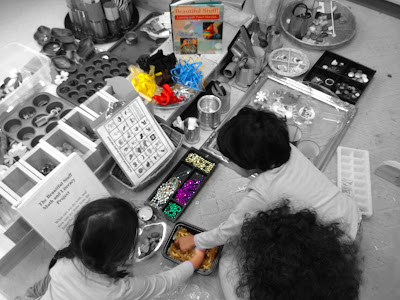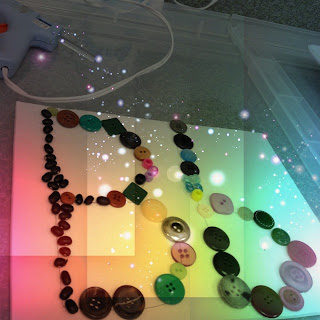 |
| This is the resource that we referred to during our Beautiful Stuff Math and Literacy Project. |
"To a young child, the world is full of materials to touch, discover, and explore. To find, collect, sort and use materials is to embark on a special kind of adventure. For adults, gathering materials, means rediscovering the richness and beauty in natural, unexpected, and recyclable objects that are all around us, but not often noticed" (Topal and Gandini, 1999, Introduction).
In their resource (photographed above), Topal and Gandini (1999) suggest that sharing the beautiful stuff is an important part of the experience (p. 1).
N. C.: I have beautiful stuff from my home! (4.3 years)
L.N.: The ribbon looks like a slide! (5.5 years)
T.M.: This golden heart is made up of solid gold (5.8 years).
I began to observe T.M. more carefully and noticed that he chose a muffin tin to organize his beautiful stuff. I decided to have a conversation with T.M. (5.8 years).
Ms. Babalis: Can you talk to me about your decisions? Why did you choose the muffin tin?
T.M.: So I have a place to organize all of my beautiful stuff!
Ms. Babalis: Why is it important to organize stuff?
T.M.: So they are not messy when guests are around. But I make a big mess when I eat! And when I play in the basement I make another big mess!
Ms. Babalis: Why do you keep things organized at school and not at home?
T.M.: I'm not sure how I can keep my stuff clean in the basement.
Ms. Babalis: Why is that?
T.M.: Because I take lots of toys at once and it's going to take an hour for me to clean it!
Ms. Babalis: How can you solve this problem?
T.M.: By taking one toy out at a time and putting back if I want to play with another toy.
Ms. Babalis: That's a good idea! I'm sure your mom will be happy.
The students in our class loved to touch the materials, organize the materials, wear the materials, talk about the materials, and use them for make believe play.
After showing students some of these special moments through photo documentation I asked, "what can we do with, and how can we learn from the beautiful stuff collected?"
L.N.: We could put it in the classroom. We could put some stuff everywhere! (5.5 years)
J.A.: We can decorate the classroom (5.2 years).
D.B.: Maybe we can use the beautiful stuff to decorate the walls and the chairs (5.10 years).
L.N.: We could try to decorate a tree with beautiful stuff (5.5 years).
As a class we came up with a consensus that we would decorate the classroom by creating a co-constructed beautiful stuff alphabet and plasticine tree.
After our consensus, our conversations with regards to the organization of the beautiful stuff became more sophisticated and focused. We were now working towards a real goal!
R.J.: We are organizing! We are trying to find things that match (4.11 years).
M.Y.: Where should we put this? (4.3 years).
J.A.: We don't want it to be so mixed up! We just looked at the materials by colour and then we put them in some trays (5.3 years).
L.N.: We sorted them! (5.5 years)
 |
| J.A.: I was sorting the colours and I was putting the right colours in the right place (5.3 years). |
And then we witnessed a unique moment, that unless you listened empathetically, or observed with an open mind you may have missed...
A.A.: We don't want to fill them up too high, so it doesn't get so really big! (4.2 years)
Ms. Babalis noticed that A.A. put a basket on top of the colourful stuff that the students had carefully sorted.
 |
| A.A.: I want to put it there, so the stuff don't fall out! |
It was so interesting that the students began to treat the beautiful stuff like magical treasures that were too precious to loose.
What an excellent way of learning about the importance of respecting classroom materials!
We were learning more through this one project than we could have ever predicted. Out of all that had emerged, we came up with a common learning goal and success criteria that focused specifically on math and literacy.
I can organize the Beautiful Stuff to create an
alphabet.
DM5. sort, classify, and display a variety of
concrete objects
DM5.1 sort, classify, and compare objects and
describe the attributes used
NS1. demonstrate an understanding of numbers, using
concrete materials to explore and investigate counting
NS1.3 begin to make use of one-to-one
correspondence in counting objects and matching groups of objects
NS1.4 demonstrate understanding of counting
concepts of stable order
□ I can sort the Beautiful Stuff by:
□ colour
□ shape
□ size
□
category
□ I can talk about how I organized the materials.
□ I can show how many materials were needed for each letter of the alphabet.
See our next post to learn more about what we have accomplished after organizing all of the beautiful stuff...
I hope that this post captured and made visible our many enchanting learning moments together...


















I love this! I definitely want to do this next year. I do however have a couple things I would like you to clarify. Am I correct in understanding that you discuss what they want to do with the beautiful stuff as a whole class, but that students sort it in small groups by invitation? Do you ever have students that don't want to sort? And if so, how do you respond to them? I am also curious how the idea of creating an alphabet came about. Was that an idea that you put in their heads or was that something that one of the students actually had themselves?
ReplyDeleteThank you for taking the time to answer my curiosities,
Erin